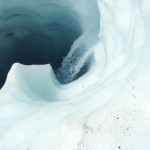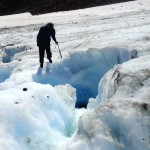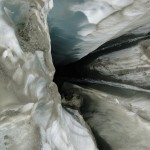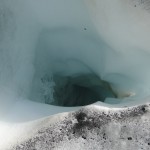November 12, 2015
Why Glaciers are not like Swiss Cheese
Posted by Mauri Pelto
- Moulin on Rainbow Glacier
- Moulin on Rainbow Glacier
- Moulin on Columbia Glacier
- Moulin on Rainbow Glacier
- Moulin on Columbia Glacier
- Moulin on Lower Curtis Glacier
There have been a number of quotes indicating that glaciers/ice sheets are like swiss cheese. Swiss cheese has holes and has little structural strength, and is often used as a metaphor to imply weakness. In the ablation zone of many glaciers there are holes, moulins, that are typically 0.5-10 m wide. A moulin is a narrow, tubular conduit in a glacier that provides a pathway for water to travel from the glacier’s surface towards the glacier base. A moulin is carved by an active flow of water, which has considerable energy as it falls. The volume of water cannot be refrozen in most cases, as there is just too much of it. As a result the water that enters a moulin eventually exits the glacier usually at the glacier base. I have observed hundreds of moulins and routinely measure their depth each summer and the ability of water communicated into them to be transmitted through the glacier using dye. Our measurements on the alpine glaciers of Alaska and Washington document typical depths of the first near vertical drop of 5-30 m. Many if not most moulins form by taking advantage of a crevasse or former crevasse via hydrofracturing. Crevasse depths are not often much greater than 30 m which is likely related to the the initial vertical drop of most moulins. At that point the moulin will access an internal drainage system. We find that the velocity of surface streams on a glacier within a kilometer of the terminus are an order of magnitude faster than the the streams of the englacial-subglacial stream system. Below is video footage from within moulins using a GoPro and of surface streams feeding into moulins in the North Cascades filmed this summer.
Moulins are not points of weakness that lead to collapse of adjacent ice. They do not develop sinkholes. They are more like a pinprick in diameter compared to the thickness of a glacier. For the Greenland Ice Sheet Das et al (2008) identified moulins delivering water to the base where the ice was 1000 m thick, the moulins less than 10 m in diameter. Joughin et al (2013) note that moulins are tied into extensive stream networks and are sparsely distributed in the lake-dominated region of the Greenland Ice Sheet. They are both small in size compared to the glacier and typically far apart, not like swiss cheese. Smith et al (2015) note this same fact mapping 532 streams all ending in moulins in an area of 6812 square kilometers. Clason et al (2015) examined the hydrology of the Leverett Glacier of western Greenland and found in their modelling a density of moulins below 1000 m is 1-3 per square kilometer and above 1000 m is less than 0.2 per square kilometer. Again the moulins are the key to delivering most meltwater to the glacier base, but are small and widely spaced compared to glacier area. McGrath et al (2011) examined a watershed on Sermeq Avannarleq, West Greeenland that had a single large mouline that was key to drainage. They found numerous englacial fractures 40-70 m below the surface in the moulin system. They further note the widespread existence of refrozen englacial voids and fractures from an old moulin. This suggests the lack of overall structural weakness imparted by moulins.
Moulins are quite important to the hydrologic system of a glacier in the ablation zone as they are such an efficient means of directing surface meltwater to the glacier base. This meltwater can accelerate the flow of a glacier, by increasing basal water pressure. If the hydrologic system is insufficient to easily transfer the water towards the glacier terminus, this leads to a high water pressure, and the water acts like a lubricating fluid. However, if the hydrologic system is sufficiently developed in part by the moulins, then the meltwater simply flows through sufficient tunnels at the base of the ice, with limited basal water pressure and do not lead to acceleration. This potential to both raise and limit ice velocity is why moulins are such an important area of research.








 Dean of Academic Affairs at Nichols College and Professor of Environmental Science at Nichols College in Massachusetts since 1989. Glaciologist directing the North Cascade Glacier Climate Project since 1984. This project monitors the mass balance and behavior of more glaciers than any other in North America.
Dean of Academic Affairs at Nichols College and Professor of Environmental Science at Nichols College in Massachusetts since 1989. Glaciologist directing the North Cascade Glacier Climate Project since 1984. This project monitors the mass balance and behavior of more glaciers than any other in North America.